Table of Contents:
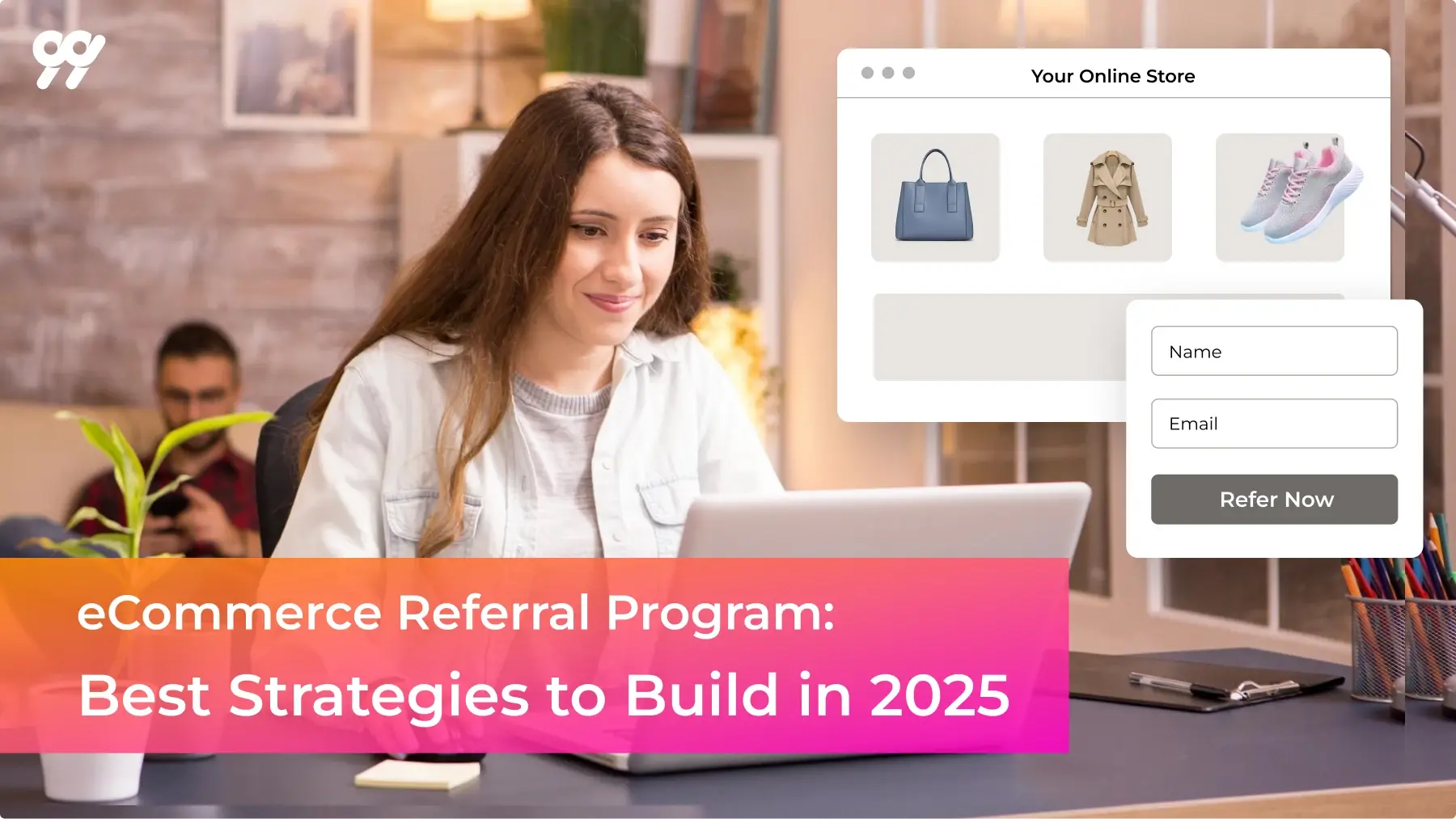
An eCommerce referral program is a strategy that rewards your existing customers for referring your products to their friends, family, or network.
Retail eCommerce brands use referral programs to expand their reach, grow their customer base, and boost revenue through trusted word of mouth. It’s a smart, scalable approach that turns satisfied shoppers into active promoters of your brand.
Unlike paid advertising or influencer campaigns, referral marketing is often more cost-effective because it leverages one of your most valuable assets: your loyal customers. By giving them a reason to recommend your store, you can create a steady stream of high-quality leads and long-term customers.
In fact, according to recent 2025 data, 65% of new business opportunities come directly from referrals. That makes referral marketing one of the most powerful eCommerce promotions to drive sustainable growth today.
In this blog, we’ll explore the benefits of running a referral program for eCommerce, look at successful real-world examples, and share the best strategies to help you build one that delivers results in 2025.
An eCommerce referral program allows customers to refer their friends, family, or social circle to your online store in exchange for rewards, such as discounts, gifts, or cash incentives. You can design these programs to be seamless and automated, enabling you to set them up once and let them run with minimal oversight.
Typically, you provide customers with a unique referral link or code that they can easily share through email, social media, or messaging apps. When someone clicks on that link and makes a purchase, both the referrer and the referred friend receive a reward based on your setup.
You might offer:
Referral software automatically tracks everything behind the scenes. It monitors clicks and conversions and identifies customers with the most new traffic. This way, you can see how effective your eCommerce referral program is without doing the heavy lifting yourself.
Referral programs can deliver serious returns for online retailers when thoughtfully planned and executed. Here are some benefits of integrating a referral program into your eCommerce promotions strategy:
Traditional advertising can be expensive, and the results aren’t always guaranteed. With referral programs, you only reward customers after they successfully bring in a new sale. This performance-based model keeps your customer acquisition cost (CAC) low and your ROI high.
Referred customers tend to convert faster and spend more. In fact, studies show that referred leads are twice as likely to convert as leads acquired through paid channels. This is because they arrive with a built-in level of trust, thanks to the recommendation from someone they know.
Referral programs attract new buyers and deepen your connection with existing ones. Rewarding your loyal customers gives them more reasons to stay engaged and make repeat purchases, building long-term relationships instead of one-time transactions.
When a customer has a great experience, they’re often eager to share it. A referral program gives them the perfect outlet to do so. This kind of organic word-of-mouth marketing can spread quickly, especially if your rewards are worth talking about.

If you seek inspiration to build your own referral engine, these real-world examples from top eCommerce brands showcase how creative and effective referral programs can be. Let’s analyze what makes them successful and explore how you can apply similar tactics in your business.
Casper, the popular online mattress brand, knows that a good night’s sleep is something worth talking about. Their referral program taps into that sentiment perfectly.
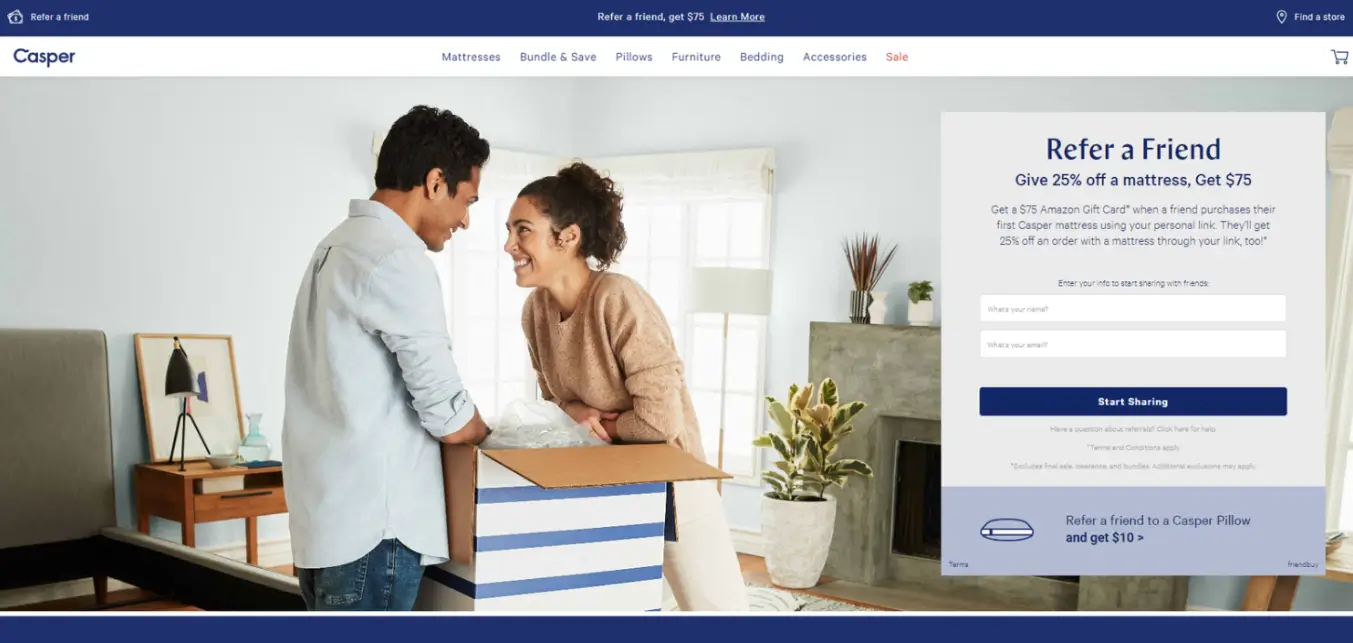
Here’s how it works: existing customers can refer friends and give them 20% off their first mattress purchase. In return, the referrer receives a $75 Amazon gift card once the purchase is completed.
What makes Casper’s program so powerful is its “give before you get” approach. This structure makes customers feel like they’re offering value to their friends, not just pushing a sale. It creates a positive emotional exchange, which is a key element in driving trust-based referrals.
Even better, the referral process is simple. Customers just enter their email to generate a unique referral link they can share via social media, email, or text. Casper also offers a secondary referral option, giving users $10 for referring to smaller accessories like pillows or sheets. This layered reward strategy keeps customers engaged, even if their network isn’t in the market for a full mattress.
Glossier has built its beauty empire on social proof, and their referral program is a natural extension of that community-first brand identity.
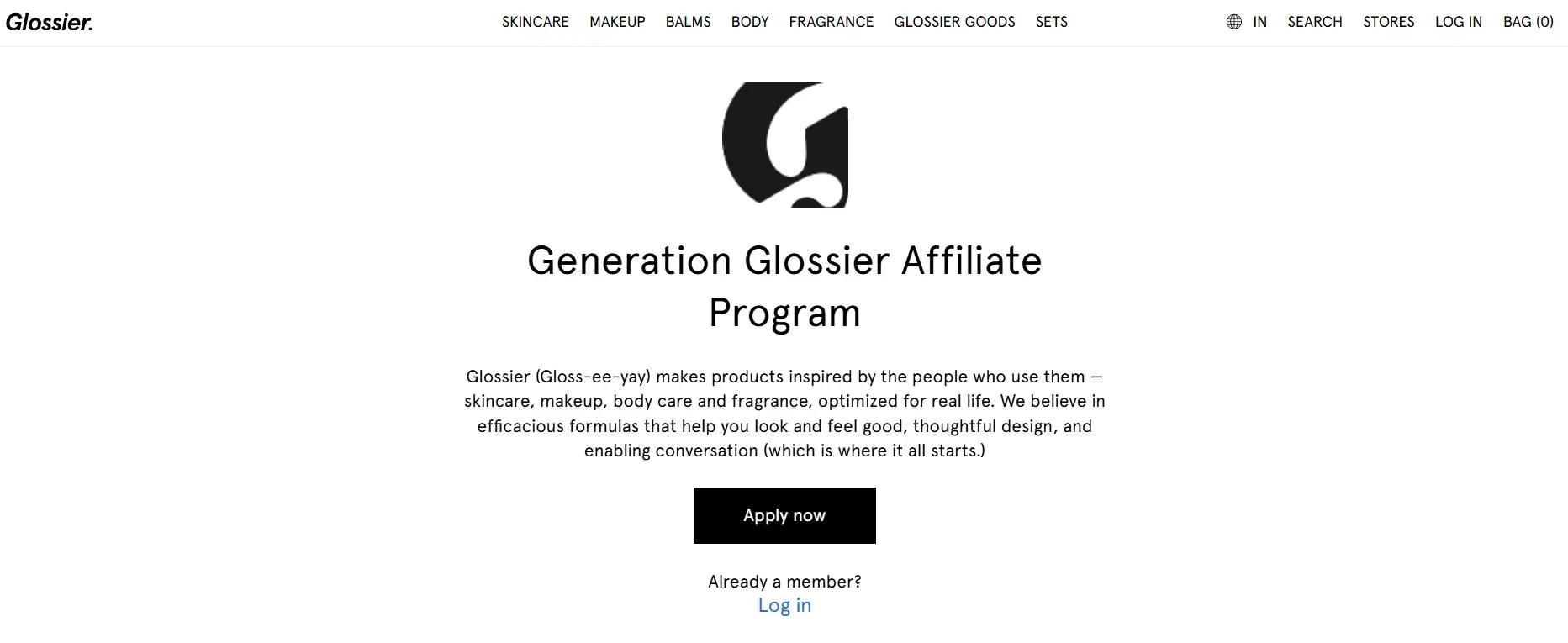
With their “Give $10, Get $10” model, customers can share a 10% off coupon with their friends, and once the friend makes a purchase, the original customer receives $10 in store credit.
It’s a clean, no-frills program, but it’s highly effective because it aligns perfectly with Glossier’s core audience: tech-savvy, socially connected millennials and Gen Z shoppers who love sharing their favorite finds.
The beauty of Glossier’s approach is in the simplicity and stickiness. Store credit rewards encourage customers to return and shop again, making it a self-reinforcing loop of referrals and repeat purchases. It’s easy to share, easy to track, and easy to redeem.
Outdoor Voices has created a strong lifestyle brand centered around movement and community. Their referral program reflects that ethos by encouraging customers to bring their friends along for the fitness journey.
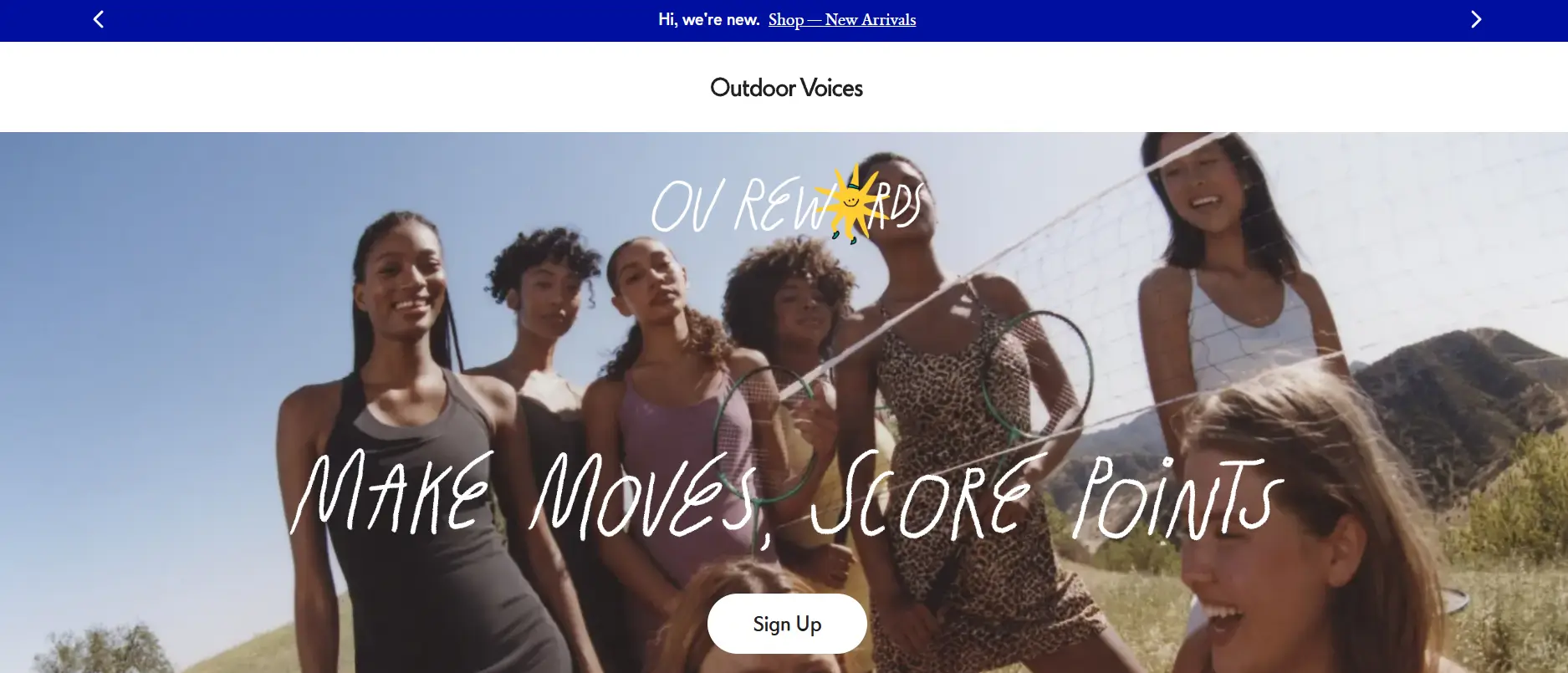
Here’s how it works: both the referrer and their friend get $20 off a purchase of $100 or more. It’s a classic “give and get” format, but with a twist—it’s framed as a way to share the lifestyle, not just the product.
The emotional appeal here is important. It doesn’t feel like a transaction. It feels like an invitation to join something bigger. This helps reinforce the brand’s identity and builds stronger bonds with customers who now see themselves as part of a like-minded community.
The deal is also smartly structured. A $100 minimum purchase threshold increases average order value, while the $20 reward is a solid incentive that doesn’t eat heavily into profit margins.
Rothy’s isn’t just selling shoes, it’s selling a mission: stylish, comfortable products made from recycled materials. Their referral program leans into that narrative beautifully.
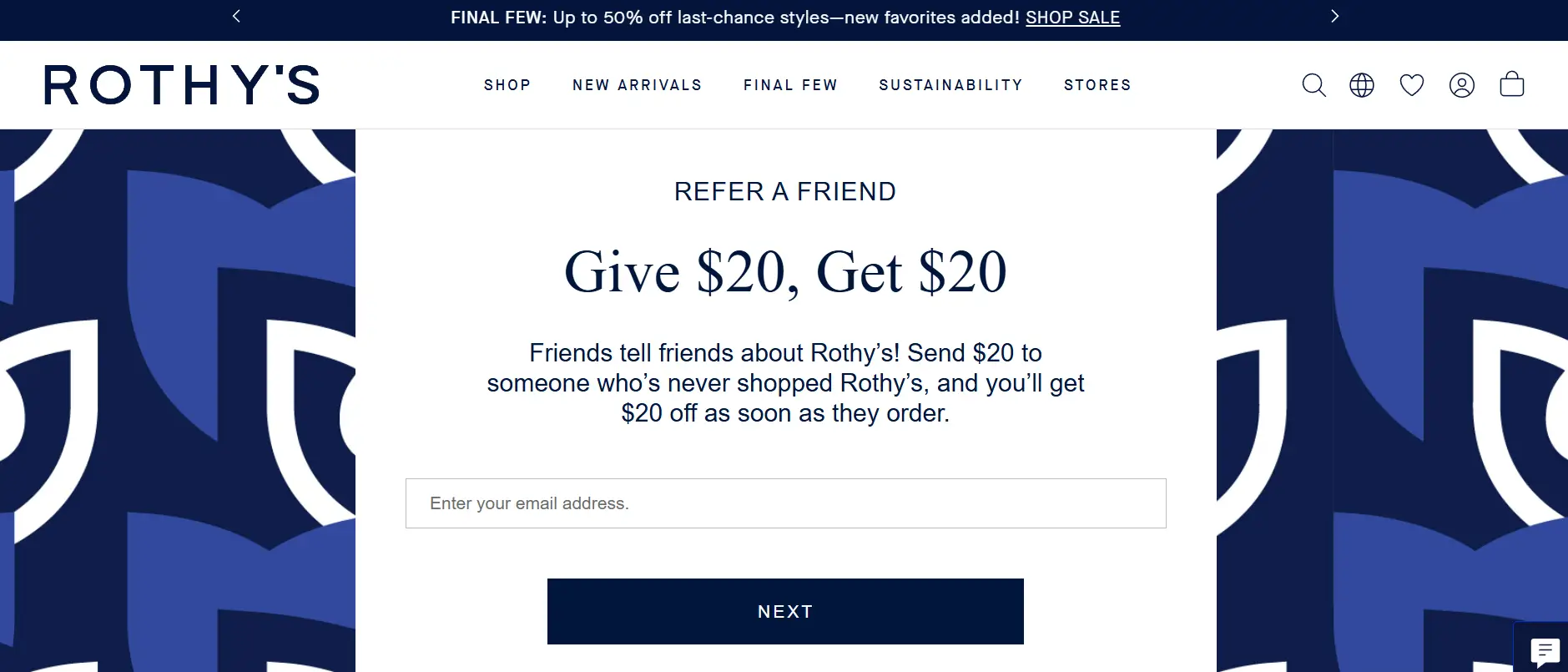
Customers who refer a friend give them $20 off their first purchase, and they also receive $20 off their next order once the friend completes their transaction.
What sets Rothy’s apart is that the program isn’t just about savings. It’s about sharing sustainable living. The brand encourages its customers to “spread the word” and be a part of the environmental movement, which makes the referral feel meaningful rather than purely promotional.
This emotional resonance adds an extra layer of motivation. Customers aren’t just earning a reward. They’re helping friends make eco-conscious choices and contributing to a shared cause. That kind of alignment between values and rewards is marketing gold.
Building a referral program might sound overwhelming, but breaking it into steps makes it easier to manage and execute. Here’s a comprehensive, step-by-step guide to help you design a referral program for eCommerce that fits your brand, engages your customers.
Start by identifying what you want your referral program to achieve, such as more customers, higher sales, or better retention. Clear goals help shape your strategy, choose the right rewards, and measure success effectively. This foundational step ensures your program aligns with your overall eCommerce promotions and business growth plans.
Think of your referral program like any other marketing campaign. It needs a purpose. Whether you’re looking to increase customer acquisition, drive repeat purchases, or raise brand awareness, you must be clear on your objectives.
Ask questions like:
Also, consult your sales and marketing teams. Discuss how this program fits into your sales funnel and how much revenue you expect to drive. Setting measurable goals helps you optimize the program later and prove its ROI to stakeholders.
Selecting the right rewards is key to motivating referrals. Choose between options like cash, discounts, loyalty points, or exclusive perks. Make sure your incentives are valuable enough to encourage sharing but sustainable for your business. The more aligned your rewards are with customer preferences, the higher your referral participation rate will be.
Let’s face it: customers won’t refer their friends just out of kindness. They need a reason. Your referral rewards should strike the right balance between motivating users and staying profitable. Here are popular reward types for eCommerce promotions:
Survey your customers to find out what rewards they care about most. The better your incentive, the more likely they’ll be to refer.
Instead of trying to build a referral system from scratch, use a proven referral program software solution designed for eCommerce like 99minds. It integrates smoothly with platforms like Shopify, WooCommerce, Magento, and BigCommerce.
It stands out because it not only supports referral programs but also combines them with loyalty rewards, gift cards, and promotional tools; making it a complete retention engine for your store. It allows you to fully customize referral incentives, track user activity, automate rewards, and prevent fraud.
Simplicity drives results. Ensure your customers can refer friends in just a few clicks using personalized links or codes. Integrate share options via email, social, or SMS. Remove friction from the process and place referral options in obvious places like thank-you pages or customer dashboards for maximum visibility and ease.
If your referral process is clunky or hard to find, people won’t bother. You need to make sharing seamless. Here’s how to streamline the process:
Use gamified pop-ups right after checkout, when customers are most excited, to boost referral participation.
Even a great referral program needs strong promotion. Announce it through transactional emails, on-site banners, social media, and packaging inserts. Run targeted campaigns to boost visibility and encourage customer participation. Treat your referral program like a key product feature and market it across every customer touchpoint.
Don’t just build your referral program — market it like you would any flagship product. Customers won’t use what they don’t know exists.
Use these channels to promote your referral program:
Promote your referral program more than once. Remind customers at different stages in the buyer journey to increase participation.
Once the program is live, the real work begins. Start tracking your referral funnel from end to end; look at metrics like referral clicks, successful signups, conversions, and top-performing advocates. Identify which channels are driving the most referrals and where drop-offs are happening.
Run A/B tests on your rewards (e.g., $10 vs. 15% off), CTA wording (“Invite & Save” vs. “Refer a Friend”), and timing (immediately post-purchase vs. after delivery). These insights allow you to refine the program over time, ensuring it stays profitable and continues to grow alongside your business.
A referral program is a smart way for eCommerce brands to grow their customer base while rewarding loyal customers.
Start by choosing the right type of reward, such as discounts, freebies, loyalty points, or exclusive perks. The better the incentive, the more likely your customers are to spread the word.
Promote your program consistently through email, blog posts, and on your website so it’s easy for customers to find and join.
As your program gains traction, track key metrics like customer lifetime value, referral-driven revenue, and overall program costs. These insights help you understand what’s working and what needs adjusting to get the most out of your referral strategy.
If you’re ready to put that data to work and scale with confidence, 99minds makes it easy to create, customize, and automate referral campaigns that fit seamlessly into your existing eCommerce promotions.
